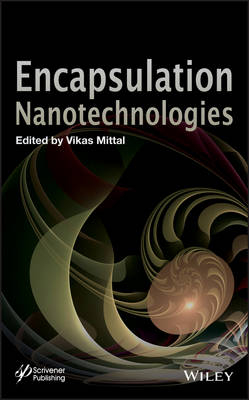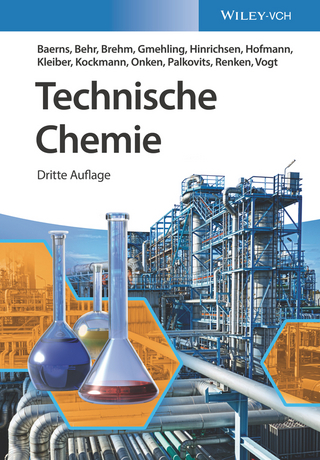
Encapsulation Nanotechnologies
Wiley-Scrivener (Verlag)
978-1-118-34455-2 (ISBN)
This unique and comprehensive book covers all the recent physical, chemical, and mechanical advancements in encapsulation nanotechnologies.
Encapsulation is prevalent in the evolutionary processes of nature, where nature protects the materials from the environment by engulfing them in a suitable shell. These natural processes are well known and have been adopted and applied in the pharmaceutical, food, agricultural, and cosmetics industries.
In recent years, because of the increased understanding of the material properties and behaviors at nanoscale, research in the encapsulation field has also moved to the generation of nanocapsules, nanocontainers, and other nano devices. One such example is the generation of self-healing nanocontainers holding corrosion inhibitors that can be used in anti-corrosion coatings. The processes used to generate such capsules have also undergone significant developments. Various technologies based on chemical, physical, and physico-chemical synthesis methods have been developed and applied successfully to generate encapsulated materials.
Because of the increasing potential and value of the new nanotechnologies and products being used in a large number of commercial processes, the need for compiling one comprehensive volume comprising the recent technological advancements is also correspondingly timely and significant. This volume not only introduces the subject of encapsulation and nanotechnologies to scientists new to the field, but also serves as a reference for experts already working in this area.
Encapsulation Nanotechnologies details in part:
The copper encapsulation of carbon nanotubes
Various aspects of the application of fluid-bed technology for the coating and encapsulation processes
The use of the electrospinning technique for encapsulation
The concept of microencapsulation by interfacial polymerization
Overviews of encapsulation technologies for organic thin-film transistors (OTFTs), polymer capsule technology, the use of supercritical fluids (such as carbon dioxide), iCVD process for large-scale applications in hybrid gas barriers
Readership
Encapsulation Nanotechnologiesis of prime interest to a wide range of materials scientists and engineers, both in industry and academia.
Vikas Mittal is currently an assistant professor in the Chemical Engineering Department of The Petroleum Institute at Abu Dhabi. He obtained his PhD in 2006 from the Swiss Federal Institute of Technology in Zurich, Switzerland. He also worked as a polymer engineer at BASF Polymer Research in Ludwigshafen, Germany. His research interests include polymer nanocomposites, compatibilization of organic and inorganic materials, polymer colloids, thermal stability studies, and anti-corrosion coatings. He has published more than fifty journal publications and authored as well as edited several books on these subjects.
Preface xiii
List of Contributors xvii
1 Copper Encapsulation of Multi-Walled Carbon Nanotubes 1
1.1 Introduction 2
1.2 Preparation of Copper Encapsulated CNTs 3
References 37
2 Novel Nanocomposites: Intercalation of Ionically Conductive Polymers into Molybdic Acid 41
2.1 Introduction 41
2.2 Experimental 47
2.3 Intercalation into Molybdic Acid 48
2.4 Preparation of Polymer-Lithium Complexes 49
2.5 Instrumentation 50
2.6 Results and Discussion 51
2.7 Conclusions 68
References 68
3 Fluid-Bed Technology for Encapsulation and Coating Purposes 71
3.1 Introduction 71
3.2 Principles of Fluidization 74
3.3 Classification of Powders 78
3.4 Fluidized Bed Coaters 80
3.5 Fluid-Bed Coating and Encapsulation Processes 88
3.6 The Design, Optimization and Scale-Up of the Coating Process and the Apparatus 94
3.7 Numerical Modeling of Fluid-Bed Coating 97
References 101
4 Use of Electrospinning for Encapsulation 107
4.1 Introduction 107
4.2 Electrospun Structures for the Encapsulation of Bioactive Substances in the Food Area 112
4.3 Electrospun Encapsulation Structures for Biomedical Applications 117
4.4 Other Uses of Electrospinning for Encapsulation 124
4.5 Outlook and Conclusions 129
References 130
5 Microencapsulation by Interfacial Polymerization 137
5.1 Introduction 137
5.2 Generalities 141
5.3 Encapsulation by Heterophase Polymerization 144
5.4 Microencapsulation by Polyaddition & Polycondensation Interfacial 148
5.5 Microencapsulation by In Situ Polymerization 158
5.6 Conclusion 166
References 167
6 Encapsulation of Silica Particles by a Thin Shell of Poly(Methyl) Methacrylate 175
6.1 Introduction 176
6.2 Synthesis of Silica (Nano)Particles and Their Surface Modification 178
6.3 Encapsulation of Silica Particles in a Thin PMMA Shell 181
6.4 Summary 198
References 199
7 Organic Thin-Film Transistors with Solution-Processed Encapsulation 203
7.1 Introduction 203
7.2 Environment-Induced Degradations of OTFTs 205
7.3 Encapsulation of OTFTs 209
7.4 Summary and Outlook 221
References 221
8 Tunable Encapsulation Property of Amphiphilic Polymer Based on Hyperbranched Polyethylenimine 225
8.1 Introduction 226
8.2 Synthesis of PEI-CAMs 228
8.3 Unimolecularity versus Aggregate of PEI-CAMs 230
8.4 Host–Guest Chemistry of PEI-CAMs 231
8.5 Charge Selective Encapsulation and Separation 233
8.6 Recognition and Separation of Anionic–Anionic Mixtures by Core Engineering of a CAM 239
8.7 Modulation of the Guest Release of a CAM 247
8.8 Concluding Remarks 250
Acknowledgements 251
References 251
9 Polymer Layers by Initiated CVD for Thin Film Gas Barrier Encapsulation 255
9.1 Introduction 256
9.2 Initiated CVD Polymerization 258
9.3 Coating by Initiated CVD 268
9.4 Advantages of iCVD in Hybrid Multilayer Gas Barriers 272
9.5 Specific Requirements for the Use in Hybrid Multilayers 276
9.6 Multilayer Gas Barriers Containing Polymers by iCVD 281
9.7 Upscaling and Utilization 285
References 287
10 Polymeric Hollow Particles for Encapsulation of Chemical Molecules 291
10.1 Introduction 292
10.2 Colloidosome Approach 295
10.3 Internal Phase Separation/Precipitation Approach 299
10.4 Self-Assembly of Amphiphilic Copolymers (Copolymer Vesicles) 305
10.4.1 From Amphiphilic Copolymers 306
10.5 Layer-by-Layer (L-b-L) Deposition 310
10.6 Unimolecular Micelles Approach 315
10.7 Heterophase Polymerization 319
10.8 Key Design Features for Applications of Hollow Polymer Particles 332
10.9 Conclusions 340
References 341
11 Protic Ionic Liquids Confinement in Macro, Meso and Microporous Materials for Proton Conduction 347
11.1 Introduction 348
11.2 Structure and Properties of Materials for Proton Conduction 351
11.3 Encapsulation Procedures and Proton Conduction Performance 365
11.4 New Activities and Development Trends 383
References 386
12 Encapsulation Methods with Supercritical Carbon Dioxide: Basis and Applications 391
12.1 Introduction 391
12.2 Supercritical Fluids – Properties 392
12.3 Particle Engineering and Encapsulation with Supercritical Fluids 394
References 419
Index 425
| Erscheint lt. Verlag | 21.6.2013 |
|---|---|
| Sprache | englisch |
| Maße | 160 x 241 mm |
| Gewicht | 780 g |
| Themenwelt | Naturwissenschaften ► Chemie ► Technische Chemie |
| Technik ► Maschinenbau | |
| Technik ► Umwelttechnik / Biotechnologie | |
| ISBN-10 | 1-118-34455-3 / 1118344553 |
| ISBN-13 | 978-1-118-34455-2 / 9781118344552 |
| Zustand | Neuware |
| Haben Sie eine Frage zum Produkt? |
aus dem Bereich


